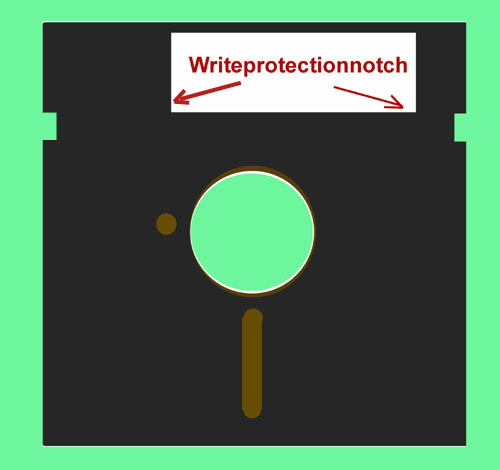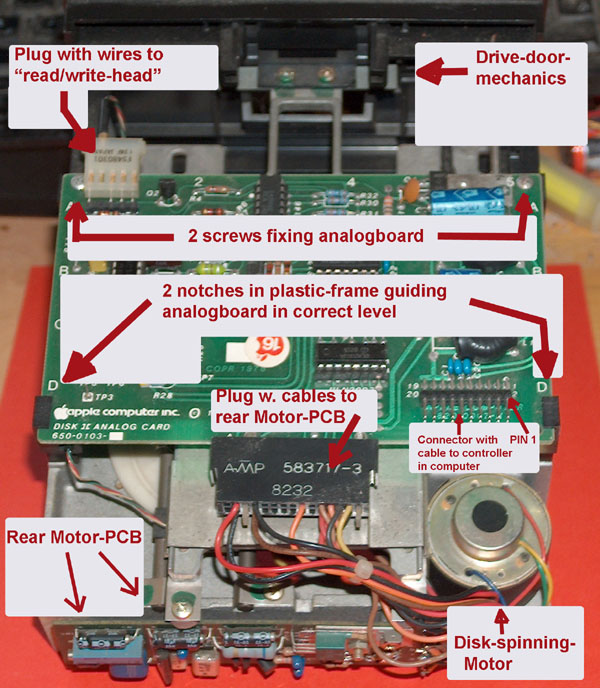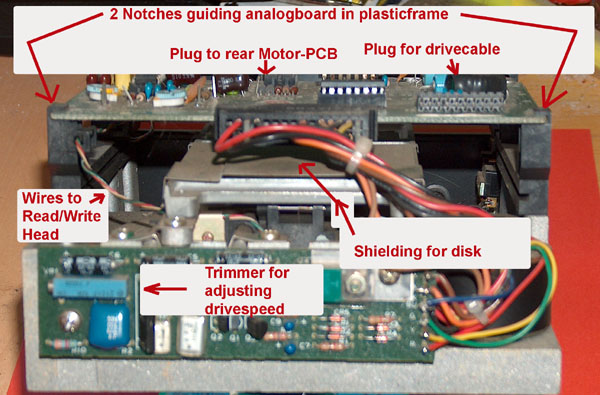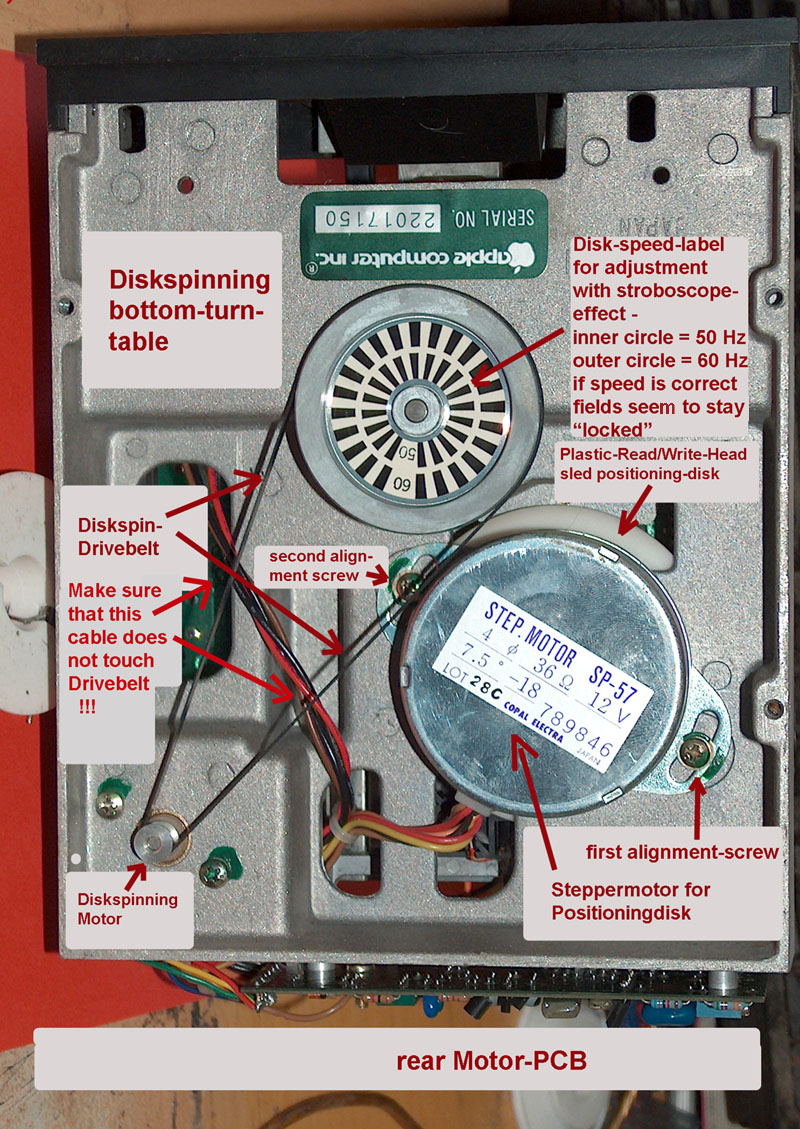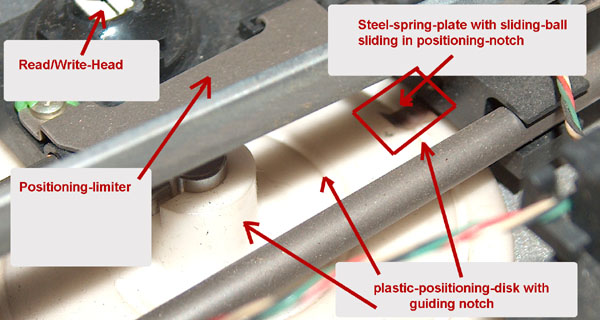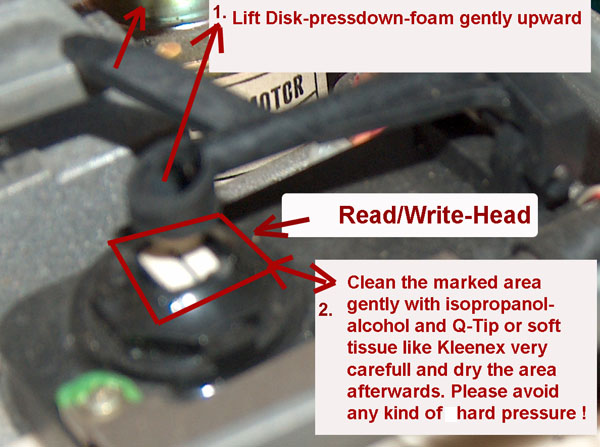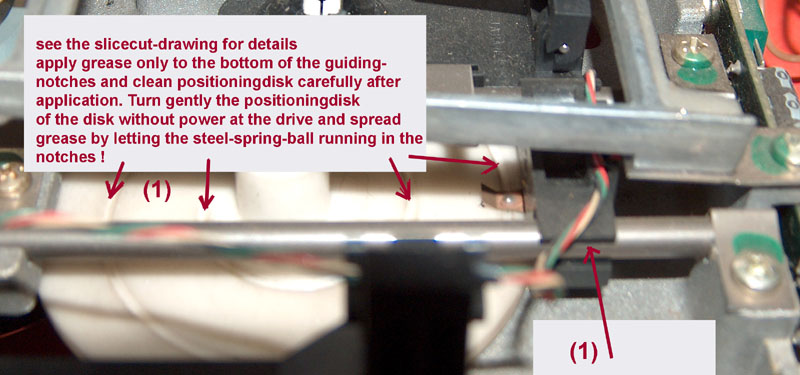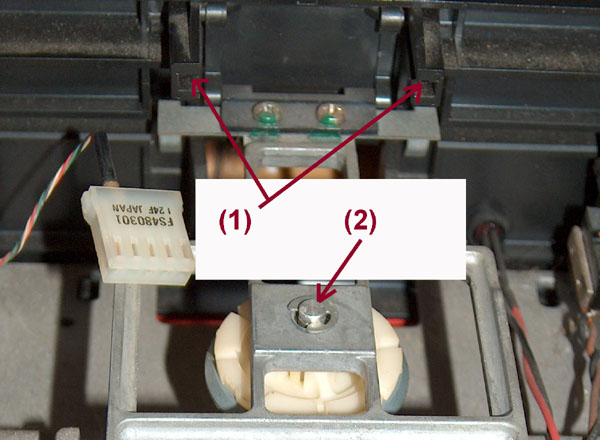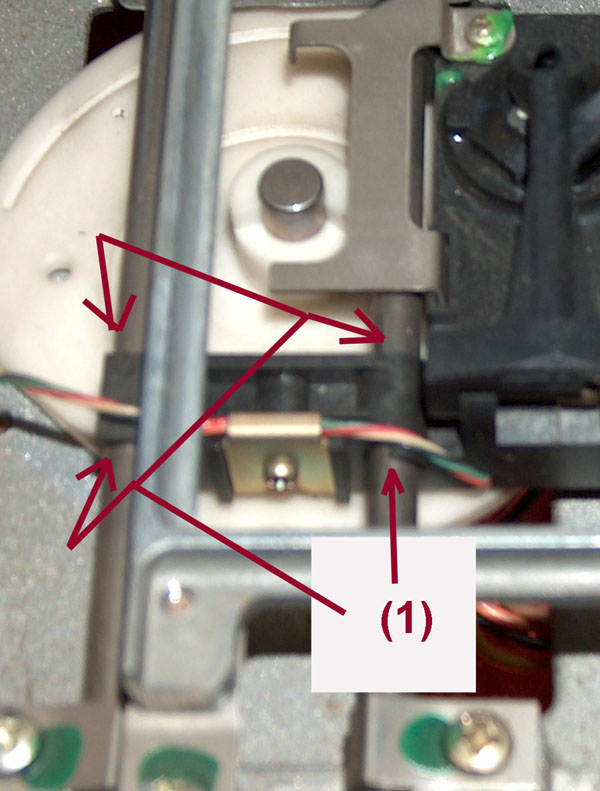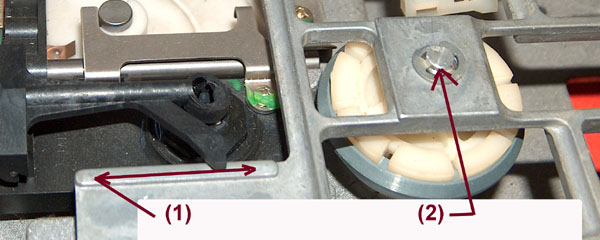APPLEBOX
The DISK][ Drive - a
classic storage system
Important Warning ! Never dismount or open
drives unless they have been disconnected
from the computer ( i.e. unplugging the drive from the
diskcontroller ) and are without power !
Disobeying may leed to a damaged computer or damaged drive !
Only
in very few tasks power will be needed and this will be mentioned
within the text at the correct place pointing to the needed
precautions!
|
|
This pages were created as a reaction of the fact that within the Applefritter-site a lot of threads are related to the topic of the Apple-Disk II- system. Due to the age of these diskdrives in a lot of cases they have malfunctions... sometimes just by dirt, sometimes caused by wrong storage and sometimes just as the result of earlier bad treatment like shocks or similar incidents. So this pages will cover the entire topics of how this drives work, which parts might become damaged and how to mantain this drives by cleaning and adjustment. I will display pictures in detail with markings inserted and comments to explain steps of service to get that drives running again in perfect shape. The order is related to the "toplist" of malfunctions ( i.e. i will treat the topics in the order sorted how often the mistakes happen .... the most common first and the rather rare mistakes thereafter ). In the preliminary part i will first explain the way this drives work to provide the user with some basic knowledge..... this should be read too because if you know how the drive works - you will know why you are doing something and what the purpose of the task targets for.... this will permit you to perform this tasks better by understanding the task itself. I hope this pages will become some kind of reference to the topic and save in future a lot of redundant threads and help to keep this drives in good working condition..... |
|
||||||||||||||||||
|
In the ancient days when this drives have been designed by Steve Wozniak, the specialized chips for diskette-drives were horrible expensive or not even designed ... so the Disk II -drive is equipped with very simple logic chips from so called "standard series" ( i.e. no specialized chips where used ). But before we examine the Drive and its components we first should take a closer view to the diskette ( media ) itself - this is important for understanding later explenations. So lets start with the following shematic-picture and the explanations of the picture in the text below: |
||||||||||||||||||||
 |
||||||||||||||||||||
|
After the first overview lets
examine first the so called "Sliceview of Disk" at the bottom:
the basical center of a diskmedia is a circle of
plastic-carrier-material that is covered with magnetic cover coating ( one side at Disks marked with "1S" and if both sides are covered with the material its marked as "2S" .... - allthough this is in very many cases not true.... a lot of diskettes marked as "1S" are in fact coated at both sides, but for some reason ( mistakes in the surface - or just because it was to much work to change the manufacturing-line ) they were marked with "1S". So it was a common habit in old days to tryout, if the backside does work or not - and it therefor was also a common habit to punch a read/write-notch in the cover with a so called "Disknotchpuncher".
That thin covered sheet of plastic covered with a magnetic surface (
mostly on both sides ) is also marked to be "SD" ( for single
Density = less quality of
In the very beginning of the
Apple the diskettes were formatted with only 13 sectors - but
after very few years it turned out to be better to use a format
of 16 In another later part we
will switch back to this picture for more detailed view and
explanation .... but at the moment we can stay with the now
explained |
||||||||||||||||||||
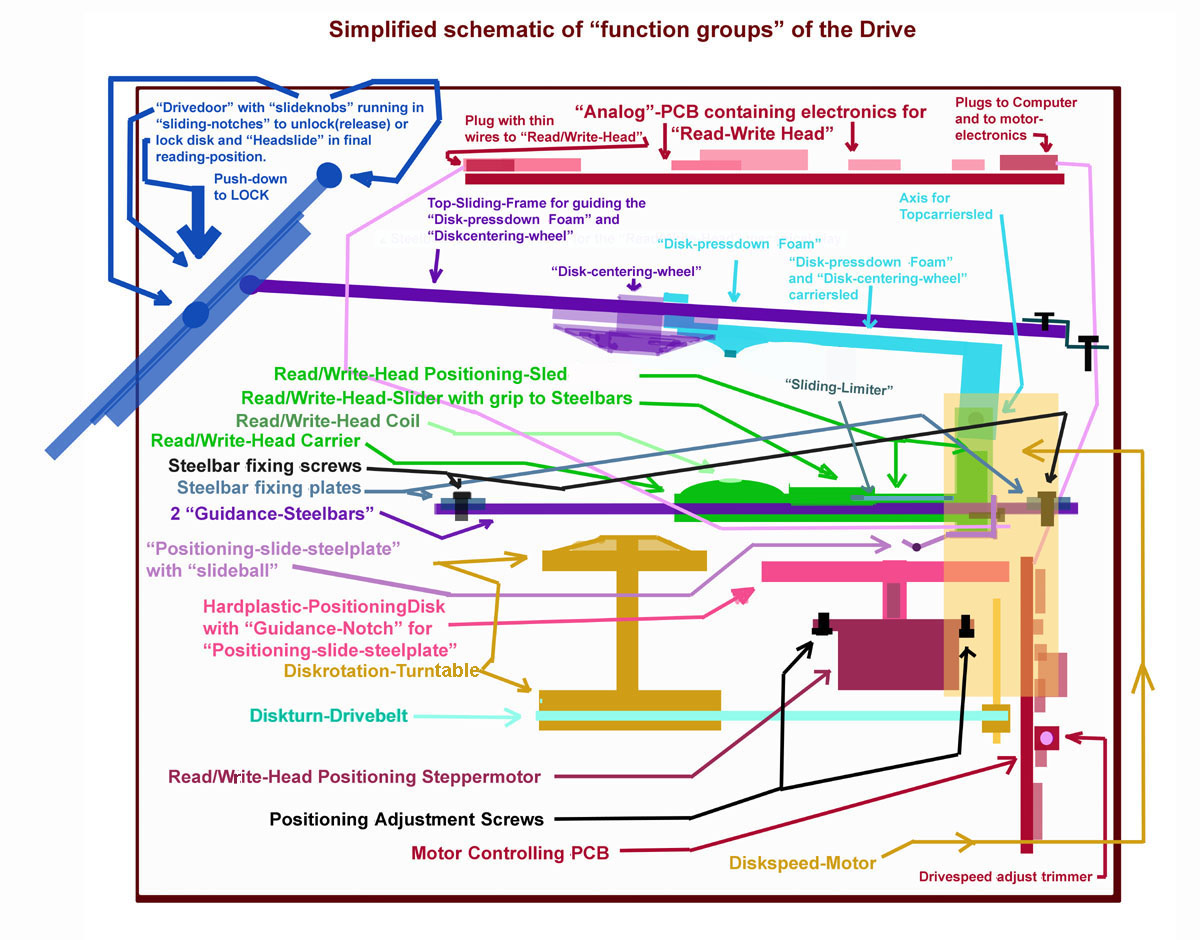 |
||||||||||||||||||||
|
When you have removed the cover of
the DISK II - drive by untightening the 4 screws at the bottom
and sliding off the hood, you will first get the sight of the
so called "Analogboard". At the front left side there is a plug with very thin wires - be very carefull with that wires - itīs the bunch of wires to the read/write- head of the drive and they may not be damaged ! At the center of the rearpart a very thick connector in the middle consists of a bunch of cables that lead to a PCB at the rearpart of the drive - which control the motor for spinning the disk and the electronics to drive the stepper motor which is responsible for the positioning of the "read/write-head sled". The "read/write-head-sled" is not visible at the moment because its beneath the shielding-top - it consists of 2 parts: the top part the moves upward and downward by opening/closing the drive door and the Steelframe where the sliding-mechanic runs along. That steelframe carries in the frontmiddle the mechanic for centering the disk in the proper position when shutting the drive door, the upper part of the sled with plasticpart that i call the "Disk-pressdown-Foam" - if the door gets shut in front with a disk inserted it gives light pressure to the disk to make sure that it is fixed close to the "read/write-head at the bottom part of the lower part of the sled. At the one side of the sled there is a piece of steel mouted that i call the "Sliding-limiter" - this part makes sure that the "read/write-head" does not move out of its disired bounderies. We will later take a closer examination to this part of steel when treating the task of positioning-mantainance....... The analogboard is fixed at the rearside by running along within notches of the plastik frame and at the front its fixed at both sides with a scew. So now at the moment first of all some pictures in the order what you will see while dismounting the drive:
So now after this pictures lets take a short look from the bottom of the drive to get some more orientation on the components:
|
||||||||||||||||||||
|
Getting the oil or grease to the right places and making sure that it keeps there and only there ! first again a short explenation: If you use oil ( specially if the oil is very liquid-fluent ) like the oil used in sewing machines isnīt a very good idea. First of all in the following time you canīt predict which directions the oil will start running to after the drive was closed, where some drops might fall down ( i.e. onto the inserted disk ? ) and some kinds of oil have the bad habit, that they get thicker like resine or vaseline and then they donīt provide good sliding attitude anymore. The best experiences i have made with little more expensive synthetic-grease as it is used for ballgears or positioning-chains in robotic systems. The consistency is quite similar to warm margerine, but it doesnīt drop around, but just is adhesive to the spots where it has been applied to. Such grease remains for years in the applied area and does not change its attitude to keep a very slippy and smoth sliding between the moving parts. In the pictures below i will mark areas with (1) or (2). The marking with (1) will mean that grease should be applied ( only very few ) and the marking (2) will indicate where a very thin fluid oil should be applied. |
||||||||||||||||||||
|
||||||||||||||||||||
|
download this page as PDF-file continue to next page about speedadjustment of the drive continue to the page about calibrating the track zero continue to the page about advanced adjustment of the offset of the electronical Read/Write-Head compensation cycle |
||||||||||||||||||||


